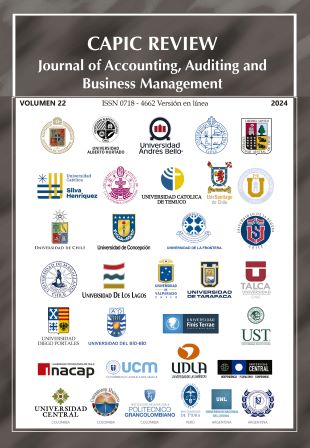Published 2024-05-10
Keywords
- Chile,
- financial performance,
- revenue diversification,
- universities
How to Cite
Copyright (c) 2024 Alejandro DÍaz Ramos

This work is licensed under a Creative Commons Attribution-NonCommercial-ShareAlike 4.0 International License.
Abstract
This study aimed to determine the existence of differences in financial performance among universities that demonstrate a high diversification of their income sources compared to those entities with low levels of income diversification in Chile. For this purpose, indicators were formulated using the annual audited financial reports that universities submit to regulatory bodies such as the Higher Education Information System and the Higher Education Superintendent. The study is applied to a sample of 53 institutions for the period from 2014 to 2021, thus constructing a panel of data with variables on which the non-parametric U Mann-Whitney test has been applied. Based on the research findings, it is concluded that institutions with higher income diversification would be characterized by: recording a larger size based on the total assets they manage, lower levels of indebtedness, a lower probability of facing a vulnerable financial situation, and a higher level of liquidity. However, statistically significant evidence is found that confirms that universities with high levels of income diversification generate lower operational margins compared to universities whose income sources are less diversified.
Downloads
References
- Abínzano I, López F. y Zabaleta I. (2022). Can tax regulations moderate revenue diversification and reduce financial distress in nonprofit organizations? Annals of Public and Cooperative Economics, 1-42. doi:10.1111/apce.12370
- Burde G. (2018). Improved methods for predicting the financial vulnerability of nonprofit organization. Administrative Sciences., 8(1), 3. doi:10.3390/admsci8010003
- Carroll, D. A., y Stater, K. J. (2009). Revenue diversification in nonprofit organizations: Does it lead to financial stability?. Journal of public administration research and theory, 19(4), 947-966. doi:10.1093/jopart/mun025
- Chang, C. F., y Tuckman, H.P. (1994). Revenue diversification among non-profits. VOLUNTAS: International Journal of Voluntary and Nonprofit Organizations, 5, 273-290. doi:10.1007/BF02354036
- Cheuk, S. (2021). Financial management capacity, accountability, own income generation, revenue diversification and financial sustainability in charities of Malasia. Studies of Applied Economics, 39(1). doi:10.25115/eea.v38i3%20(2).4279
- Chikoto G. y Neely D. (2016). Exploring the nexus of nonprofit financial stability and financial growth. VOLUNTAS: International Journal of Voluntary and Nonprofit Organization., 27(6), 2561-2575. doi:10.1007/s11266-016-9786-0
- Chikoto, G. L., y Neely, D. G. (2014). Building nonprofit financial capacity: The impact of revenue concentration and overhead costs. Nonprofit and Voluntary Sector Quarterly, 43(3), 570-588. doi:10.1177/0899764012474120
- de Andrés-Alonso, P., García-Rodríguez, I., y Romero-Merino, M.E. (2015). The dangers of assessing the financial vulnerability of nonprofits using traditional measures: The case of the nongovernmental development organizations in the United Kingdom. Nonprofit Management and Leadership., 25(4), 371-382. doi:10.1002/nml.21134
- Díaz A., y Angüis Y.,(2023). Diferencias en el desempeño financiero entre universidades de investigación y universidades docentes en Chile. Formación Universitaria, 16(5), 1-16,
- http://dx.doi.org/10.4067/S0718-50062023000500001
- Díaz, A. (2021). Análisis de la Rentabilidad de las Universidades Chilenas mediante la aplicación del Sistema DuPont. CAPIC REVIEW, 18, 1–15. https://doi.org/10.35928/cr.vol18.2020.98
- Frumkin, P., y Keating, E. K. (2011). Diversification reconsidered: The risks and rewards of revenue concentration. Journal of social entrepreneurship, 2(2), 151-164. doi:10.1080/19420676.2011.614630
- Githaiga, P. N. (2022). Revenue diversification and financial sustainability of microfinance institutions. Asian Journal of Accounting Research, 7(1), 31-43. doi:10.1108/AJAR-11-2020-0122
- Gordon, T. P., Fischer, M., Greenlee, J., y Keating, E. K. (2013). Warning signs: Nonprofit insolvency indicators. International Research Journal of Applied Finance, 4(3), 343-378.
- Greenlee J. y Trussel J. (2000). Predicting the Financial Vulnerability of Charitable Organization. Nonprofit Managment and Leadership, 11(2), 199-210. doi:10.1002/nml.11205
- Hager M. (2001). Financial vulnerability among arts organizations: A test of the Tuckman-Chang measures. Nonprofit and voluntary sector quarterly., 30(2), 376-392. doi:10.1177/0899764001302010
- Herfindahl O.C. (1950). Concentration in the steel industry. New York: Columbia University.
- Irvine, H., y Ryan, C. (2019). The financial health of Australian universities: policy implications in a changing enviornment. Accounting, Auditing & Accountability Journal, 32(5), 1500-1531. doi:10.1108/AAAJ-03-2018-3391
- Le, T. T., Nguyen, T. L., Trinh, M. T., Nguyen, M. H., Nguyen, M. P. T., y Pham, H. H. (2021). Adopting the Hirschman-Herfindahl Index to estimate the financial sustainability of Vietnamese public universities. Humanities and Social Sciences Communications, 8(1), 1-10. doi:10.1057/s41599-021-00927-2
- Lu J, Lin W. y Wang Q. (2019). Does a more diversified revenue structure lead to greater financial capacity and less vulnerability in nonprofit organizations? A bibliometric and meta-analysis. VOLUNTAS: International Journal of Voluntary and Nonprofit Organization., 30(3), 593-609. doi:10.1007/s11266-019-00093-9
- Mann H. y Whitney D. (1947). On a test of whether one of two random variables is stochastically larger than the other. The annals of mathematical statistics, 18(1), 50-60. Obtenido de https://www.jstor.org/stable/2236101
- Mayer, W. J., Wang, H. C., Egginton, J. F., y Flint, H. S. (2014). The impact of revenue diversification on expected revenue and volatility for nonprofit organizations. Nonprofit and Voluntary Sector Quarterly, 43(2), 374-392. doi:10.1177/08997640124646
- Mazanec J, Bartosova V. y Bohm P. (2022). Logit Model for Estimating Non-Profit Organizations’ Financial Status as a Part of Non-Profit Financial Management. Mathematics, 10(13), 2162. doi:10.3390/math10132162
- Mazanec J. y Bartosova V. (2021). Prediction Model as Sustainability Tool for Assessing Financial Status of Non-Profit Organizations in the Slovak Republic. Sustainability, 13(17), 9721. doi:10.3390/su13179721
- Nik Ahmad, N. N., Ismail, S., y Siraj, S. A. (2019). Financial sustainability of Malaysian public universities: officers perceptions. International Journal of Education Management, 33(2), 317-334. doi:10.1108/IJEM-06-2017-0140
- Ohlson, J. A. (1980). Financial ratios and the probabilistic prediction of bankruptcy. Journal of accounting research, 109-131. doi:10.2307/2490395
- Olinski, M., y Szamrowski, P. (2020). Entrepreunerial activities of public benefit organization. Entrepreneurship and Sustainability Issues, 8(1), 853. doi:10.9770/jesi.2020.8.1(57)
- Student. (1908). The probable error of a mean. Biometrika, 1-25. doi:10.1093/biomet/6.1.1
- Tevel, E., Katz, H., y Brock, D. (2015). Nonprofit financial vulnerability: Testing competing models, recommended improvements, and implications. VOLUNTAS: International Journal of Voluntary and Nonprofit Organizations., 26(6), 2500-2516. doi:10.1007/s11266-014-9523-5
- Trussel, J.M. (2002). Revisiting the Prediction of Financial Vulnerability. Nonprofit Managment and Leadership, 13(1), 17-31. doi:10.1002/nml.13103
- Tuckman, H. P., y Chang, C. F. (1991). A methodology for measuring the financial vulnerability of charitable nonprofit organizations. Nonprofit and voluntary sector quarterly, 20(4), 445-460. doi:10.1177/089976409102000407
- Wicker, P., y Breuer, C. (2014). Examining the financial condition of sport governing bodies: The effects of revenue diversification and organizational success factors. VOLUNTAS: International Journal of Voluntary and Nonprofit Organizations, 25, 929-948. doi:10.1007/s11266-013-9387-0
- Yan, J., Mmbaga, N., y Gras, D. (2023). In pursuit of diversification opportunities, efficiency, and revenue diversification: A generalization and extension for social entrepreneurship. Strategic Entrepreneurship Journal, 17(1), 132-159. doi:10.1002/sej.1446



































